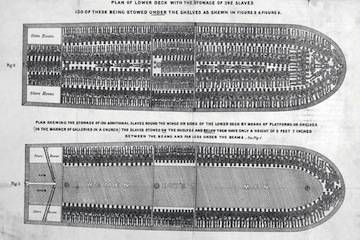The Atlantic Slave Trade to the United States
Between the 16th and 19th centuries, around 12 million slaves were transported from Africa to the Americas. Around 450,000 of them ended up in what is now the United States. Of these 450,000, perhaps 200,000 arrived after the independence of the country in 1776. The slave trade to the United States continued legally until 1808, at which point the Constitution permitted laws against it to be passed. A smaller trickle of smuggled slaves continued thereafter. By the start of the Civil War, four million slaves resided in the United States. Though they lived in the South by 1860, slaves arrived in all regions of colonial North America. Between one and two million died on the overseas passage. In the Americas as a whole, more people arrived via the Atlantic slave trade than by any other means. In parts of the Caribbean, nearly 100% of the modern population is descended from the slave trade.
The people who were shipped across the Atlantic were treated and packed as cargo. The great preoccupation of the shipowners was to fit as many slaves as possible into the smallest area. They were crammed under the deck, generally chained to their places, and fed as cheaply as was possible. The cramped conditions caused many to get sick and die. The voyage took over two months. Slaves were laid out horizontally, much like sardines. Multiple hundreds were on the typical voyage. The long-term average death rate, over the course of the trade, was around 15% per voyage. A bad voyage might see a third of its cargo dead. The air was putrid below deck. To keep the death rate from being even higher, slaves were often chained together and taken above deck during the day, and were forced to move around. Many ships had barricades on deck that the crew could retreat behind in case of a revolt.
In the colonial days the British were active participants in the Atlantic slave trade. British ships would procure slaves in Africa and take them to places like Jamaica, Barbados, the Virgin Islands, or Virginia. Here they would load up with sugar (from the Caribbean) or tobacco (from Virginia) and return to Great Britain. The third leg of the journey was to take rum and manufactured goods to Africa, which they could trade with local rulers for additional slaves. This was known as the "triangular trade". It was favored by the prevailing wind patterns on the Atlantic Ocean, which blow from east to west out of Africa, and west to east out of North America. The leg of the trade from Africa to the Americas was known as the Middle Passage.
Revolts did happen from time to time. For the captain of a slave ship, mutiny could come from the slaves themselves, or from the crew. Crews generally came from the lowest order of society, were raised in violence, and had immense death rates themselves from tropical disease. A lot of them were convicted criminals sentenced to serve on the ships. The cat-of-nine was used on crew and slave alike, brutally, to dissuade any from thinking of rebellion. One slave revolt succeeded in taking over the Amistad in 1839, leading to a famous U.S. Supreme Court case (United States v. The Amistad). Since the ship was engaged in illegal trade under U.S. law, the slaves detained on it were freed. This was far from the only revolt. Over 500 have been documented over the course of the trade. The ultimate victory for the slaves was to gain control of their ship and return it to Africa. To fail in a revolt, however, meant almost certain death.
Most of the slaves came from coastal West Africa. The ancestry of those in the Americas represents a small subset of all the African groups. The southern and eastern parts of the continent escaped the Atlantic slave trade, although there were separate routes feeding the Middle East and Indian Ocean. Some of the most common ethnicities of the slaves were the Bakongo, the Mandé, the Gbe, the Akan, the Wolof, and the Igbo. Little effort was made to preserve these distinctions in the United States (or anywhere else in the Americas), and they were gradually lost in favor of a more general black identity.
By any measure, the Atlantic slave trade was one of the great human crimes of the last thousand years.
